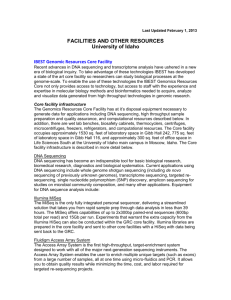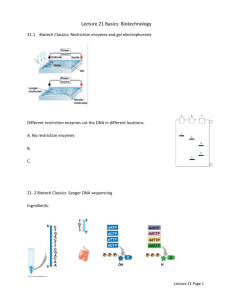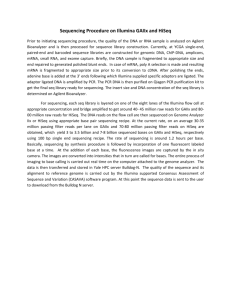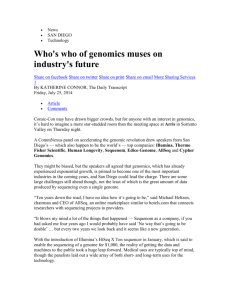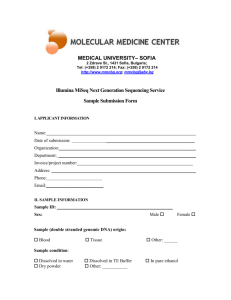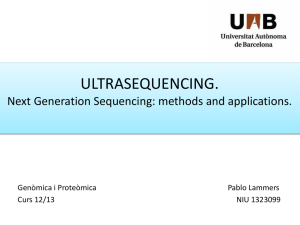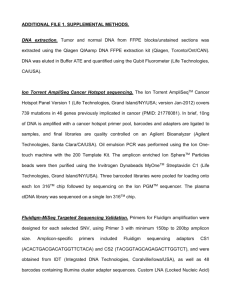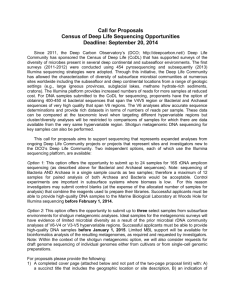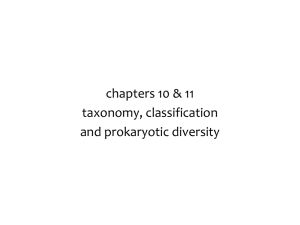docx - IBEST - University of Idaho
advertisement
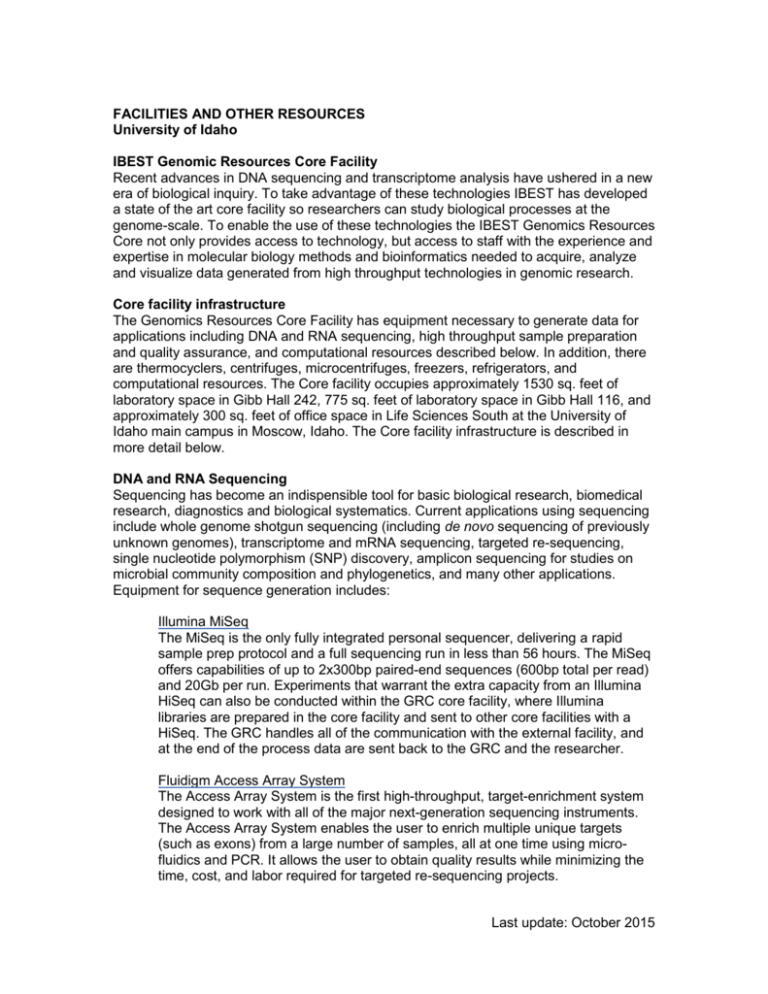
FACILITIES AND OTHER RESOURCES University of Idaho IBEST Genomic Resources Core Facility Recent advances in DNA sequencing and transcriptome analysis have ushered in a new era of biological inquiry. To take advantage of these technologies IBEST has developed a state of the art core facility so researchers can study biological processes at the genome-scale. To enable the use of these technologies the IBEST Genomics Resources Core not only provides access to technology, but access to staff with the experience and expertise in molecular biology methods and bioinformatics needed to acquire, analyze and visualize data generated from high throughput technologies in genomic research. Core facility infrastructure The Genomics Resources Core Facility has equipment necessary to generate data for applications including DNA and RNA sequencing, high throughput sample preparation and quality assurance, and computational resources described below. In addition, there are thermocyclers, centrifuges, microcentrifuges, freezers, refrigerators, and computational resources. The Core facility occupies approximately 1530 sq. feet of laboratory space in Gibb Hall 242, 775 sq. feet of laboratory space in Gibb Hall 116, and approximately 300 sq. feet of office space in Life Sciences South at the University of Idaho main campus in Moscow, Idaho. The Core facility infrastructure is described in more detail below. DNA and RNA Sequencing Sequencing has become an indispensible tool for basic biological research, biomedical research, diagnostics and biological systematics. Current applications using sequencing include whole genome shotgun sequencing (including de novo sequencing of previously unknown genomes), transcriptome and mRNA sequencing, targeted re-sequencing, single nucleotide polymorphism (SNP) discovery, amplicon sequencing for studies on microbial community composition and phylogenetics, and many other applications. Equipment for sequence generation includes: Illumina MiSeq The MiSeq is the only fully integrated personal sequencer, delivering a rapid sample prep protocol and a full sequencing run in less than 56 hours. The MiSeq offers capabilities of up to 2x300bp paired-end sequences (600bp total per read) and 20Gb per run. Experiments that warrant the extra capacity from an Illumina HiSeq can also be conducted within the GRC core facility, where Illumina libraries are prepared in the core facility and sent to other core facilities with a HiSeq. The GRC handles all of the communication with the external facility, and at the end of the process data are sent back to the GRC and the researcher. Fluidigm Access Array System The Access Array System is the first high-throughput, target-enrichment system designed to work with all of the major next-generation sequencing instruments. The Access Array System enables the user to enrich multiple unique targets (such as exons) from a large number of samples, all at one time using microfluidics and PCR. It allows the user to obtain quality results while minimizing the time, cost, and labor required for targeted re-sequencing projects. Last update: October 2015 Apollo 324 for NGS Library Preparation The Apollo 324 is a benchtop system that automates next-generation sequence library preparation workflows (Illumina TruSeq/Nextera libraries) by using bead technology to execute high-performance isolation and purification. Advanced Analytical Fragment Analyzer The Fragment Analyzer is a 12-lane electrophoresis array that provides accurate fragment quantification and qualification. It can quantify genomic DNA, total or purified mRNA, and prepared libraries in a range of sensitivities. High Throughput Sample Preparation and Quality Assurance Access to equipment for high throughput sample preparation gives investigators abilities for increased speed and reduction of sample-to-sample variability over manual methods without having to hire new technicians. In addition providing high-end equipment for generating sample data, the Core enables researchers to perform accurate assessment of sample quality before committing extensive financial resources to a project. Equipment for sample preparation and QA in the Core include: Kingfisher Flex: The Kingfisher Flex is a bead-based sample preparation system that eliminates pipette steps and the resulting waste from its protocols. It is a fully automated, scalable, and customizable system that delivers rapid and consistent results for RNA and DNA. Qiagen QIAxcel: The QIAxcel system is a multicapillary electrophoresis system designed to overcome the bottlenecks of gel electrophoresis. The fully automated system can process up to 96 samples per run. Molecular Devices SpectraMax Paradigm: The SpectraMax Paradigm is a multimode microplate detection platform. It is the only user upgradeable microplate reader on the market that allows for real-time system configuration. Current cartridges include the absorbance (ABS) detection and the tunable wavelength (TUNE) detection cartridges. Fluorometry: The DNA or RNA in samples can be quantified using fluorescent assays. For multiple samples in a 96-well plate format these assays can be done using the Gemini XPS microplate reader from Molecular Devices, smaller numbers of samples can be assayed using the Qubit 2.0 from Life Technologies. Covaris Ultrasonicator 2200: The ultrasonicator shears DNA to a specified size rapidly while maintaining a consistent size distribution for any number of samples. It is invaluable for protocols requiring precise and replicable DNA fragment sizes. Aurora System: A revolutionary platform for nucleic acid extraction based on a powerful electrophoretic purification technology from Boreal Genomics. The electrophoretic extraction technology is proven to purify DNA and RNA from extremely low abundance and heavily inhibited samples including soils from the Atacama Desert, Antarctic tundra, sea sediments, oil sands, and stool. StepOne Plus qPCR instrument: Accurate quantification of sequenceable library is essential for a successful sequence run. This instrument allows for rapid and Last update: October 2015 accurate quantification of Illumina libraries, thus improving cluster management on the flow cell and sequence quality. BioRad T100 PCR instrument: The T100 thermal cycler is a small thermal cycler offering a comprehensive set of convenient features in a small footprint. This compact thermal cycler features an intuitive touch-screen user interface to make running PCR easy in up to 96-well format. Bioinformatics Analysis Resources The GRC offers bioinformatics support through staff bioinformaticians and can perform a full range of analysis tasks to address biological questions in areas such as population genetics, genomics, microbial community dynamics, functional genomics and systems biology. GRC bioinformaticians begin with raw data output from the equipment and proceed from quality assurance, data processing and analysis. This eventually leads to data interpretation and visualization. Analyses are done using software pipelines available in the public domain or ones developed by the Core, and project specific methods are used when needed. Core personnel have developed analysis techniques and pipelines for genome assembly, transcriptome assembly, population variant analysis, SNP/INDEL detection, and RNA-seq analysis. These pipelines transform raw data into a form and format that can be mined by investigators. Data processing occurs through a feedback loop with investigators. The core relies on feedback from investigators after preliminary data analysis, so that adjustments in output content, form and format can be made. The data is re-analyzed or additional analyses are done until the project meets its goals, figures are generated and summary tables are provided to the investigators in a form that is useful to them. As needed, the Core staff provides investigators with detailed knowledge of the laboratory protocols and bioinformatics methods used so they can be included in reports and publications as needed. Core staff assist in the preparation of figures and tables for publications and poster presentations as needed and are included as co-authors on publications when they make significant intellectual contributions to a project. Last update: October 2015
